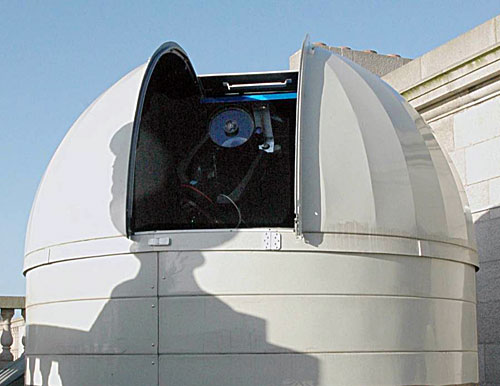School of Physics Opens New Astronomy Observatory
Posted on: 05 February 2009
The School of Physics’s new astronomy observatory was recently opened by astrophysicist, Dame Jocelyn Bell Burnell. The observatory has been named after the 19th century amateur astronomer, William Monck, the first person to successfully make photoelectric observations of the planets. The new teaching observatory contains optical, solar and radio telescopes and is situated on the roof of Trinity College’s Fitzgerald Building.
The opening of the observatory by Dame Jocelyn Bell Burnell marks the return of practical observing to the TCD campus. The Dunsink Observatory which was founded in the second half of the 18th century was established with a bequest from a former provost of TCD and one of its directors was Sir William Rowan Hamilton. The launch of TCD’s new observatory also coincides with the global celebrations of the International Year of Astronomy 2009.
The School of Physics’s new astronomy observatory is equipped for practical astronomical observations over a wide range of wavelengths. Commenting on the significance of the astronomy observatory and the equipment’s capacity for observation, Dr Brian Espey, Senior Lecturer in Physics and Astrophysics Course Director said: “Its suite of instrumentation can examine a range of physical phenomena, ranging from the solar atmosphere and explosive eruptions using a combination of optical and radio techniques to their effects on our own ionosphere as detected by Very Low Frequency (VLF) waves. Additionally, the spectroscopic capabilities of the radio telescope, centred on the important atomic hydrogen line at 1420MHz (21cm), enables the structure and dynamics of the galaxy to be mapped”.
“Furthermore, despite the bright and radio-noisy surroundings, tests have shown that, with a judicious choice of techniques, the observatory instruments can detect fainter phenomena such as radio observations of the thermal radiation from the moon, and also at least one extragalactic object. Unfiltered short-exposure camera observations (with the 11″ Celestron probe) allow for a visual magnitude of ~ 15, about 10,000 times fainter than the faintest star visible to the naked eye in a dark sky. The telescopes will also be used for part of the time for direct visual observations as this, most direct and intimate, form of observing still makes a big impact on the students.”

New TCD Astronomy Observatory
